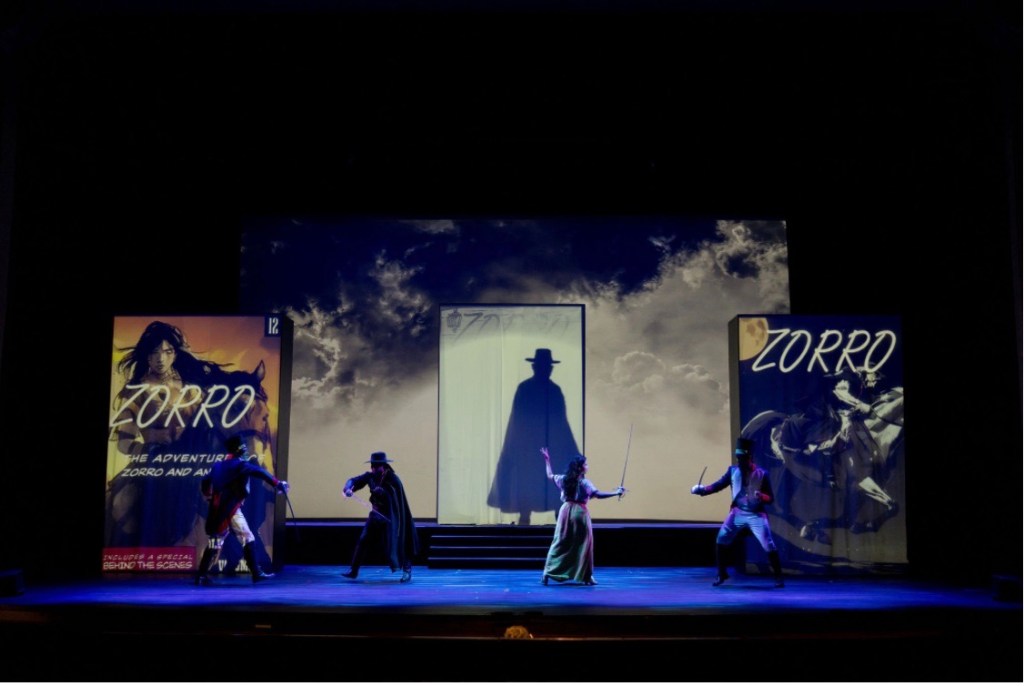By generalizing standards of the high-low cultural spectrum, the worlds of comic books and grand opera are worlds apart, one pulpy fun and the other lofty by nature. Or are they? The implied question came into focus with Opera Santa Barbara’s (OSB) sharply realized and roundly entertaining production of Zorro, which closed out OSB’s season with great crowd-pleasing gusto last weekend at the Lobero Theatre.
Both realms, after all, innately indulge in irrationality of dramatic means, free-range melodrama and overstated conflicts of good and evil. Villains and heroes often arrive without shades of gray, and there is an understood pact with the audience that realism has been suspended for the broad storytelling cause.
At the Lobero, the twain of the two worlds met in various ways, and with surprisingly natural crossover. It started with David Chapman’s imaginative staging scheme using projections on large moveable panels onstage to convey shifting scenery, backstories, and sometimes flashing comic-book-style illustrations of swordplay. Even the supertitle text winked in the direction of comic book culture, in the Comic Sans font.
Naturally, the very genesis of originator Johnston McCulley’s Zorro superhero saga is the stuff of comic-book fantasy. On top of the graphic novel/operatic resonance involved, composer-librettist Héctor Armienta’s tale from early-19th-century Los Angeles also entails social commentary and sympathy for the exploited and oppressed mestizos of the day. Serious and timeless themes hum beneath the surfaces of the romantic opera — with pinches of comic relief (mostly through the whimsical antics of Sergeant Gomez (Omar Rodriguez) and his love-in-training, Luisa (Sunwoo Park).
Potent, flexible vocal work marked the principles — Oriana Falla’s sympathetic freedom fighter (and love interest) Ana Maria; Kelly Guerra as the more complex, societally mobile Carlotta; and Bernardo Bermudez as the comic-bookishly sinister and racist mayor. Our Zorro, a k a Diego de la Vega, is brought fully to life through the handsome countenance and vocal aplomb of tenor Xavier Prado.
As perhaps another instance of modern perspective woven into the opera, woman power is embedded in the story, through Carlotta’s crafty interventions and the motivating force of Ana Maria to rouse Diego into revolutionary action — to finally exclaim “I will fight for justice and nothing will stop me.” His masked-man Zorro transformation carries with it shades of the Lois Lane/Clark Kent hidden-identity game.
In general, the OSB production was a polished gem, partly thanks to the experienced hands of those involved. The opera premiered at Albuquerque’s Opera Southwest, in conjunction with the Fort Worth Opera, and parties returning from that opening involved in Santa Barbara include director Octavio Cardenas, set and projection designer Chapman, and conductor Anthony Barrese, leading a taut and sonorous small orchestra. Impressive local classical guitarist Chris Fossek lent flamenco authenticity to the musical fabric — a touch that relates to the flamenco-friendly environment of Santa Barbara, especially come “Old Spanish Days.”
All in all, Zorro proved to be a win-win operation as a season finale for the Kostis Protopapas–directed OSB, which has bravely weathered pandemic struggles and the post-pandemic lull for high culture. Here we had an example of a definitively contemporary opera that exerts the populist appeal of an attractively tonal musical language and a mostly irony-free sum effect.
Zorro represents a branch of modern opera with potential to appeal to admitted opera-philes while also luring in new opera fans. No doubt, that act of cultural evangelism transpired at the Lobero, right down to the final swashbuckling, score-settling, final “Z” slashing scene.
Premier Events
Sat, May 04
2:00 PM
Santa Barbara
In-Person and Online Talk: “Scientific Foundations of Musical Expression”
Sat, May 04
10:00 AM
Solvang
Touch A Truck
Sat, May 04
11:00 AM
Santa Barbara
Mental Wellness Center’s 28th Annual Arts Faire
Sat, May 04
11:00 AM
Santa Barbara
Community History Day
Sat, May 04
3:00 PM
Solvang
The SYV Chorale Presents Disney Magic Concert
Sat, May 04
4:00 PM
Santa Barbara
Santa Barbara Treble Clef Women’s Chorus Spring Concert and Reception
Sat, May 04
7:00 PM
Santa Barbara
A Star Wars Cantina Celebration: Renegades, Rebels, and Rogues
Tue, May 07
7:00 PM
Santa Barbara
Theatre Eclectic Presents “The Great Gatsby” – Wake Auditorium
Thu, May 09
11:00 AM
Santa Barbara
Friendship Center’s Mother’s Day Celebration
Thu, May 09
7:00 PM
SANTA BARBARA
San Marcos High School Theater Presents, “Singin’ in the Rain”
Fri, May 10
12:00 PM
Santa Barbara
Mother’s Day Weekend at Art & Soul
Sat, May 04 2:00 PM
Santa Barbara
In-Person and Online Talk: “Scientific Foundations of Musical Expression”
Sat, May 04 10:00 AM
Solvang
Touch A Truck
Sat, May 04 11:00 AM
Santa Barbara
Mental Wellness Center’s 28th Annual Arts Faire
Sat, May 04 11:00 AM
Santa Barbara
Community History Day
Sat, May 04 3:00 PM
Solvang
The SYV Chorale Presents Disney Magic Concert
Sat, May 04 4:00 PM
Santa Barbara
Santa Barbara Treble Clef Women’s Chorus Spring Concert and Reception
Sat, May 04 7:00 PM
Santa Barbara
A Star Wars Cantina Celebration: Renegades, Rebels, and Rogues
Tue, May 07 7:00 PM
Santa Barbara
Theatre Eclectic Presents “The Great Gatsby” – Wake Auditorium
Thu, May 09 11:00 AM
Santa Barbara
Friendship Center’s Mother’s Day Celebration
Thu, May 09 7:00 PM
SANTA BARBARA
San Marcos High School Theater Presents, “Singin’ in the Rain”
Fri, May 10 12:00 PM
Santa Barbara

